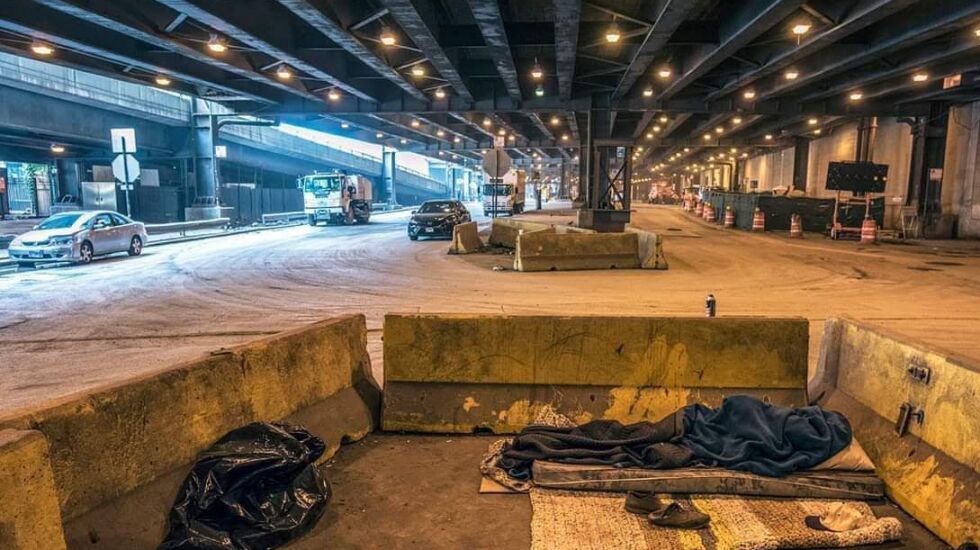
A man with a shaggy beard and an “I wake up awesome” T-shirt sat on a plastic chair in the shade of a pair of locust trees.
A dusty flat-screen TV, a fridge and a window AC unit cluttered the dirt outside his tent.
“Good morning, buddy. How you doing?” asked an approaching stranger.
Michael Ferguson, the new arrival, cut to the chase, asking the homeless man if he has an alcohol problem.
“In my opinion or my doctor’s?” said the other man, whose name is Frank.
A half-dozen cans of Icehouse beer littered the seat of Frank’s walker.
“They’re for a party coming up,” Frank said.
The cans were all open.
Ferguson is a community outreach worker. One day last week he was traipsing across the Uptown lakefront, not far from where a group of homeless people and their supporters had been protesting the building of a luxury high-rise — and complaining they were about to be booted from parkland to make way for a nature sanctuary.
“I don’t know nothing about a sanctuary. I just want them to get off drugs,” Ferguson said.
Ferguson has short, sensible hair and an immaculately trimmed beard. His teeth gleam. His belly bulges against a black polo shirt.
A glance at his legs offers a fuller story: The skin is blotchy with pink scars, a reminder of his before life. He spent 12 years homeless, much of it in the shadows of Lower Wacker Drive.
Ferguson must sell his story to wary would-be customers, and he covers a lot of ground — up to 300 miles in a week. So his life story spills out like a two-minute elevator pitch: Sixteen years as a carpenter before he got injured and became addicted to pain meds, then heroin and crack cocaine. His brushes with death — too many to count. The time a drug dealer smacked him in the mouth with a pistol, knocking out six teeth. He scrolled through snapshots on his phone: the metal plates and screws holding his jaws together, a pouch filled with needles, an X-ray of the titanium hip replacement he needed after a bone infection caused by shooting up and repeatedly missing the vein.
And yet, Ferguson, 40, was really only scratching the surface.
So he doesn’t forget, Ferguson keeps a photograph of his bedraggled, emaciated self in his 26th and State Street office; in it, he’s holding a cardboard sign that reads: “Hungry as F---.”

“Because you would never imagine that that could have been him,” said Maria Bruni, Ferguson’s boss and senior vice president at Family Guidance Centers Inc., a behavioral health clinic with 12 locations in Illinois.
Ferguson has been clean for three years and eight months — and on the job with Family Guidance for about three months.
It’s as if Ferguson has risen from the dead — and he can’t quite believe it. Last year, he attended a gala fundraiser at Above and Beyond Family Recovery Center on the West Side, which Ferguson credits for finally helping him quit drugs. He wore a tuxedo.
“How much did you donate, sir?” he remembered a fellow attendee asking him. “Are you a diamond or a gold member? I’m like, ‘I’m not a donor, I’m a drug addict.’”
But he doesn’t use any longer.
“I don’t want the consequences that come along with it: being homeless, dying,” he said. And he likes being able to see his three kids; the youngest was 2 when Ferguson tumbled into street life.

It’s Ferguson’s transformation — and his ability to talk the language of those needing help — that makes him so valuable.
“His lived experience and his understanding of substance abuse disorder make him incredibly empathetic with others who are struggling,” Bruni said. “He really understands how to engage with people.”
Dan Hostetler, the executive director at Above and Beyond, described Ferguson as an “icon.” Ferguson spent two years at the center.
“When he got here, he was skin and bones. He was in pretty bad shape,” Hostetler said. After counseling, “he’s a kind of model of what anybody could become, and we use him as an icon all the time, because he came in here as broken as anyone we’ve ever seen.”

Frank, the homeless man sitting in the shade, eyed Ferguson warily at first. Then his gaze drifted to Ferguson’s legs. Ferguson reeled off all the miseries he endured as a drug addict.
“I can get you into detox,” Ferguson said.
Frank dismissed the suggestion, saying he’d tried it all before.
Ferguson asked Frank if he’s ever tried Vivitrol, an injectable medicine for alcohol dependence.
Frank shook his head.
“You’ll be throwing up and s----ing yourself if you drink [alcohol] on the Vivitrol shot,” Ferguson said.
But the treatment works, Ferguson added.
Ferguson left a business card. Frank wanted to keep talking. But Ferguson knows when to walk away. He was pretty sure Frank wouldn’t take him up on his offer.
“Look at his red face. He’s been swigging that s--- so long, it’s coming out of his pores,” Ferguson said when he was out of earshot.
And besides, Ferguson had lots more people to see.
“You’ve got to keep it cut and dried,” he said, “because there are people out there who really need help.”







